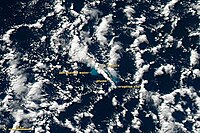2012 Kermadec Islands eruption and pumice raft
| 2012 Kermadec Islands eruption | |
|---|---|

NASA image of Havre Seamount eruption and initial formation of pumice raft
|
|
| Volcano | Havre Seamount |
| Date | 18–19 July 2012 |
| Time | Morning |
| Type | Submarine |
| Location |
Kermadec Islands 31°07′13″S 179°58′07″W / 31.12028°S 179.96861°W |
The 2012 Kermadec Islands eruption was a major undersea volcanic eruption that was produced by the previously little-known Havre Seamount near the L'Esperance and L'Havre Rocks in the Kermadec Islands of New Zealand. The large volume of low density pumice produced by the eruption accumulated as a large area of floating pumice, a pumice raft, that was originally covering a surface of 400 square kilometres (150 square miles), spread to a continuous float of between 19,000 and 26,000 square kilometres (7,500 and 10,000 sq mi) and within three months dispersed to an area of more than twice the size of New Zealand.
The thickness of the raft may initially have been as high as 3.5 metres (11 feet) and was reduced to around 0.5 metres (1 foot 8 inches) within a month.
Three months after the eruption, the mass had dispersed into very dilute rafts and ribbons of floating pumice clasts. Most pumice clasts became waterlogged and sunk to the sea floor while some flocks have stranded in the Tonga islands, on the northern shores of New Zealand, and eventually on the eastern coast of Australia one year after the eruption.
The eruption of the Havre Seamount was not initially noticed by scientists, and volcanologists were not even aware that the Havre Seamount was an active submarine volcano. After the pumice raft was detected, researchers retrospectively examined satellite imagery and past seismic activity in an attempt to pinpoint the time and location of the eruption that produced the pumice raft.Seismologists discovered a cluster of earthquakes (ranging in magnitude between 3.0 and 4.8) that occurred 18–19 July 2012. These earthquakes were consistent with magma rising into a magma chamber prior to eruption. Analysis of satellite imagery showed an ash plume appear on 18 July 2012 and conclude several days later. Although some volcanologists initially believed that the eruption might have occurred at the Monowai Seamount, this possibility was later ruled out. It is also believed that the eruption was unrelated to the 2012 Te Māri eruption at New Zealand's Mount Tongariro.
...
Wikipedia
